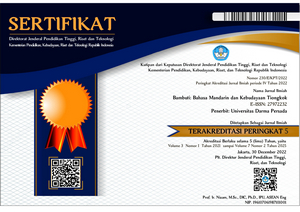COHERENCE AND COHESION IN THE INSTRUCTIVE TEXTS OF CHINESE BUN RECIPES
KOHERENSI DAN KOHESI DALAM TEKS INSTRUKTIF RESEP BAKPAO BERBAHASA MANDARIN
Abstract
This article describes coherence and cohesion in the instructive (procedural) text of Chinese bun recipes. This paper aims to explain the coherence of meaning and form in the instructive text. By adhering to the view of positivism, the study used methods of content analysis and variation analysis of discourse, focusing on structural categories in the text, including forms and meanings in clauses. The coherence of meaning and form in the instructive text of bun recipes is interrelated. The coherence of meaning indicates the relations of parallels between instructions, expressed by verbs, and also result in a chronological relation, expresses successive and progression. There is no contradiction in the instructions. In this instructive text of the Chinese bun recipes, there is also an individual identity as a coherence marker, refers to the concept of buns skin and buns filling. Grammatical cohesion is showed by anaphoric references, subject ellipsis, and conjunctions of succesive relation. Lexical cohesion is indicated by reiteration, namely repetitions, such as noun, verb, preposition, and conjunction. Reiteration is also expressed by synonyms such as verb, preposition, and conjunction synonyms, as well as hyponyms and hyperonyms expressed by the inclusion of meaning in the ingredients for making buns.

This work is licensed under a Lisensi Creative Commons Atribusi 4.0 Internasional.
Authors who publish with this journal agree to the following terms:
- Authors retain copyright and grant the journal right of first publication with the work simultaneously licensed under a Lisensi Creative Commons Atribusi 4.0 Internasional that allows others to share the work with an acknowledgment of the work's authorship and initial publication in this journal.
- Authors are able to enter into separate, additional contractual arrangements for the non-exclusive distribution of the journal's published version of the work (e.g., post it to an institutional repository or publish it in a book), with an acknowledgment of its initial publication in this journal.
- Authors are permitted and encouraged to post their work online (e.g., in institutional repositories or on their website) prior to and during the submission process, as it can lead to productive exchanges, as well as earlier and greater citation of published work (See The Effect of Open Access).









